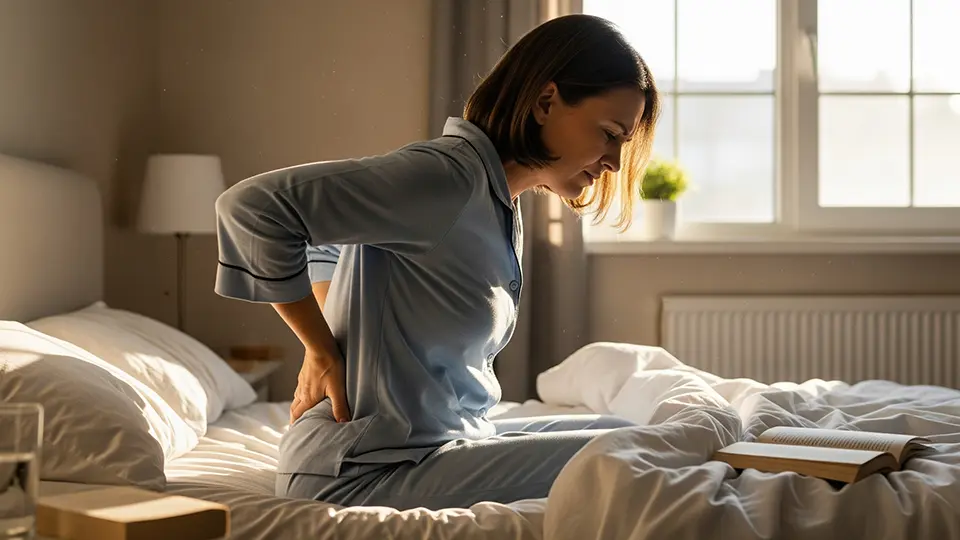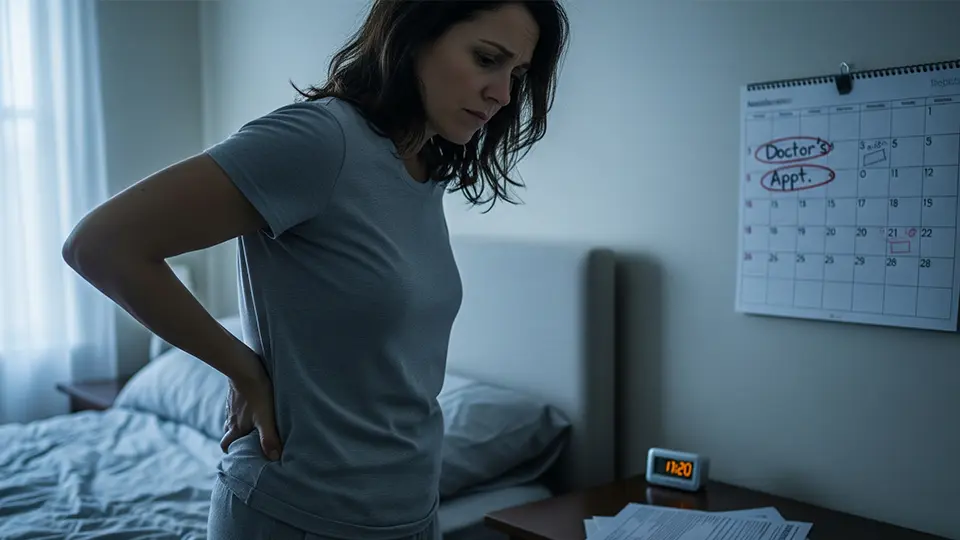Table of Contents
Waking up with lower back stiffness or pain can make mornings miserable. If you’re someone who dreads getting out of bed due to discomfort, you’re not alone. Many adults between the ages of 30 and 60 experience this issue regularly. Fortunately, morning lower back pain physiotherapy offers proven methods to not just relieve but also fix the root causes of this recurring problem.
In this blog, we’ll dive into why your lower back hurts in the morning, the most common causes, and how morning lower back pain physiotherapy can help you reclaim your mornings pain-free.
Common Causes of Morning Lower Back Pain
Before implementing a treatment plan with morning lower back pain, it’s essential to understand what may be triggering your discomfort. Identifying the root cause is the first step toward long-lasting relief.

a. Poor Sleeping Posture
Sleeping in unsupported or awkward positions can strain your muscles and misalign your spine. A saggy mattress, an overly soft bed, or an unsupportive pillow can place stress on the lower back. Over time, this results in chronic pain that worsens overnight and becomes most noticeable in the morning.
b. Inflammatory Conditions
Chronic inflammatory diseases such as ankylosing spondylitis, rheumatoid arthritis, or osteoarthritis tend to flare up in the early morning hours. These conditions often cause stiffness and pain that improves after movement begins. Morning stiffness lasting longer than 30 minutes may indicate an inflammatory source and can be significantly helped with physiotherapy techniques like guided mobility exercises and joint mobilizations.
c. Weak Core and Muscle Imbalances
When your core muscles are weak, the lower back compensates, leading to poor spinal support and increased stress during sleep. Additionally, tight hamstrings and hip flexors can alter pelvic alignment, pulling the spine into unnatural positions. These imbalances are commonly addressed in morning back pain physiotherapy with strengthening and flexibility routines.
d. Herniated Discs
Spinal discs naturally rehydrate and swell while lying down at night. If a disc is herniated or bulging, this swelling can put pressure on nearby nerves, especially in the lumbar region. This causes sharp or dull pain in the morning that may lessen as the day progresses. A physiotherapist can design specific exercises to relieve pressure on the affected discs and improve spinal health.
e. Physical Inactivity
During sleep, your body remains relatively immobile for several hours. This lack of movement can lead to joint stiffness, poor circulation, and increased muscle tightness, especially if you already have pre-existing musculoskeletal issues. Incorporating gentle morning stretches and low-impact movement as part of a physiotherapy routine can counteract this stiffness and jumpstart circulation.
Why is Lower Back Pain worse in the Morning?

Back pain that strikes hardest in the morning is more than just an annoyance — it’s often a sign of deeper biomechanical or inflammatory issues. Here’s a closer look into why physiotherapy is especially effective in dealing with this pain pattern:
Prolonged Inactivity: Overnight, your muscles and connective tissues rest, but without movement, circulation slows, synovial fluid becomes less viscous, and your joints stiffen. That’s why your first steps out of bed can feel like you’re 80 years old — even if you’re only 35.
Circadian Rhythm and Inflammation: Studies show that the body’s natural cortisol (anti-inflammatory hormone) levels are lowest around 4–6 AM. This dip increases inflammation for people with arthritis or degenerative disc disease, resulting in higher pain and stiffness upon waking.
Spinal Disc Behavior: When lying down, intervertebral discs rehydrate and expand slightly. For someone with disc issues, this expansion can create pressure on nerves first thing in the morning — hence why morning back pain physiotherapy routines are designed to ease the spine into mobility gradually.
Muscle Guarding: Chronic pain can cause subconscious muscle bracing while you sleep. Physiotherapy uses techniques like diaphragmatic breathing and progressive relaxation to help patients address muscle guarding behaviors.
Risk Factors that Contribute to Morning Lower Back Pain
You’re more likely to wake up with lower back pain after sleeping if you have:

- Sleeping on an overly soft or worn-out mattress
- Poor pillow support causing spinal misalignment
- Long hours of sitting or inactivity during the day
- Weak glutes and deep core stabilizers
- Poor posture at work or home
- Inflammatory diet high in processed foods
- High body mass index (BMI)
- History of spinal injury or herniation
Being aware of these factors allows you to make proactive changes.
Lifestyle changes that support Healing

While physiotherapy is the cornerstone of treatment, your daily habits either support or sabotage your recovery. Here are deeper strategies that work synergistically with your physiotherapy plan:
Create a Pre-Bed Stretch Routine
Engage in a 10-minute routine before bed that includes gentle spinal rotations, hamstring stretches, and breathing exercises. These reduce overnight stiffness by promoting muscle elongation and circulation.
Mind-Body Approaches
Add techniques such as:
- Mindfulness or guided imagery: to reduce stress-related muscle tension.
- Sleep tracking apps: to monitor and improve sleep quality, which directly impacts pain perception.
Hydration and Spinal Health
Your discs are 80% water. Dehydration overnight can worsen disc pain in the morning. Drink a full glass of water within 30 minutes of waking and throughout the day to keep your spine supple.
Anti-Inflammatory Supplements
In coordination with a healthcare provider, consider:
- Turmeric/Curcumin
- Magnesium
- Vitamin D and Omega-3s
These natural aids complement morning lower back pain physiotherapy by reducing systemic inflammation and muscle cramping.
How Physiotherapy eases Lower Back Pain after sleeping
Physiotherapy focuses on root-cause correction, not just symptom relief. Here’s how it helps:

a. Full Physical Assessment
Your physiotherapist will assess your walking pattern, sitting posture, core strength, hip mobility, spinal curvature, and sleeping habits. This deep analysis helps craft a personalized recovery plan.
b. Manual Therapy Techniques
Techniques such as soft tissue mobilization, trigger point therapy, and spinal manipulation release tension from overactive muscles. Mobilizations restore joint movement, helping reduce early morning stiffness.
c. Custom Exercise Routines
Therapists design routines that correct muscular imbalances. These may include:
- Core stabilizing exercises (planks, dead bugs)
- Hip flexibility drills (lunges, hip openers)
- Spinal decompression stretches (child’s pose, cobra)
Progress is monitored weekly, and routines are updated as your strength and flexibility improve.
d. Sleep Ergonomics Education
Your physiotherapist may recommend a firm mattress, memory foam pillow, or using a body pillow to maintain spinal alignment during sleep. Sleeping on your side with a pillow between your knees can also help.
e. Postural Retraining
Training your body to maintain optimal posture throughout the day reduces the stress on your spine at night. This includes correcting screen height, adjusting your chair support, and engaging your core during daily tasks.
Top 7 Exercises for Morning Lower Back Pain Relief
These gentle movements are ideal to start your day pain-free:
1. Knee-to-Chest Stretch

- Lie on your back, knees bent
- Pull one knee toward your chest, hold for 20 seconds
- Repeat with the other leg, then with both knees
2. Pelvic Tilt

- Lie on your back, knees bent, feet flat
- Tighten your abdominal muscles to flatten your back against the floor
- Hold for 10 seconds, repeat 10 times
3. Cat-Cow Movement

- Start on hands and knees
- Arch your back (cat), then drop your belly and lift your head (cow)
- Repeat slowly for 1–2 minutes
4. Child’s Pose

- Kneel and sit back on heels
- Stretch arms forward and lower your torso to the floor
- Hold for 30 seconds to 1 minute
5. Glute Bridge

- Lie on your back, knees bent, feet flat
- Lift hips while squeezing glutes, hold for 5 seconds
- Repeat 10–12 times
These exercises activate your muscles, boost circulation, and reduce stiffness.
6. Supine Twist

- Lie on your back, arms stretched out like a “T.”
- Drop your knees to one side while keeping shoulders flat.
- Hold 30 seconds; switch sides.
- Great for spinal decompression and core mobility.
7. Bridge Pose

- Lie on your back, knees bent, feet hip-width apart.
- Press into heels and lift hips, engaging glutes.
- Strengthens lower back and core, reduces strain over time.
Red Flags – When Morning Lower Back Pain may Signal something serious
Although morning lower back pain physiotherapy is highly effective, there are scenarios where pain may indicate something more urgent. Consult a doctor if you notice:

- Persistent fever or unexplained weight loss
- History of cancer or osteoporosis
- Night sweats or severe nighttime pain
- Loss of bladder or bowel control (could indicate Cauda Equina Syndrome)
Physiotherapists are trained to recognize these red flags and will refer you to the appropriate specialist if needed.
Case Study: How Sarah beat morning lower back pain with Physiotherapy
Meet Sarah, a 42-year-old office manager. She began experiencing intense lower back pain every morning — sometimes so bad she had to roll out of bed sideways. After just 4 weeks of a personalized morning lower back pain plan that included core strengthening, posture correction, and tailored stretches, Sarah reported:

- 80% reduction in morning stiffness
- Ability to get out of bed with ease
- Improved sleep quality and reduced anxiety
Her success story isn’t uncommon. With commitment and professional guidance, recovery is entirely possible.
When to seek help from a Physiotherapist
Don’t ignore ongoing morning lower back pain after sleeping. Seek help if:

- Pain persists longer than 10–14 days
- It limits your ability to walk, sit, or bend
- You experience radiating pain, numbness, or weakness in legs
- Rest and stretching don’t improve symptoms
- You’ve had previous spinal issues or surgery
Early physiotherapy intervention prevents complications and speeds recovery.
Additional Therapies that Complement Physiotherapy
If morning lower back pain persists, these supportive therapies may enhance results:

- Dry Needling: Relieves deep muscle knots that don’t respond to stretching
- Acupuncture: Balances energy flow and reduces inflammation
- Cupping Therapy: Increases blood flow, relaxes tight fascia
- Massage Therapy: Eases muscle tension and improves sleep
- Chiropractic Care: Aligns joints to reduce nerve compression
- CBT (Cognitive Behavioral Therapy): Helps you manage pain perception and anxiety related to chronic pain
Be sure to consult your physiotherapist before combining treatments.
Nutrition and Sleep Hygiene for Morning Lower Back Pain
Morning lower back pain relief isn’t just physical—it’s also nutritional and behavioral:

a. Hydration
- Drink at least 8–10 glasses of water daily
- Dehydrated discs lose shock-absorbing capacity
b. Anti-Inflammatory Diet
- Add leafy greens, turmeric, salmon, walnuts, berries
- Avoid sugary, processed foods and fried items
c. Sleep Hygiene
- Maintain a consistent sleep schedule—even on weekends
- Avoid screens 1 hour before bed
- Create a dark, cool sleep environment
- Avoid caffeine or heavy meals after 7 PM
These small daily choices greatly influence your spine’s ability to heal.
Final thoughts & Call to Action
You don’t have to start your day in discomfort. With the right physiotherapy plan, morning lower back pain can be reduced and even eliminated over time. From guided exercises to hands-on therapy and sleep adjustments, you can reclaim restful nights and energetic mornings.
💡 Don’t wait for your pain to become chronic—schedule your physiotherapy consultation with Dr.Iqra Kiran today and wake up pain-free tomorrow!
FAQs (Frequently Asked Questions)
Is it normal to wake up with lower back pain?
No, waking up with back pain indicates poor sleep posture, spinal issues, or weak core muscles. Physiotherapy can resolve these underlying causes.
Can stretching really help for morning lower back pain?
Absolutely. Gentle, targeted stretches increase blood flow, improve flexibility, and reduce muscle tension.
How fast can I expect results?
Many people see improvement within 2–4 weeks of consistent physiotherapy and daily exercises.
Should I stop exercising until my pain improves?
No. Gentle, controlled movement helps reduce stiffness and accelerates healing. Avoid high-impact or painful activities.
Can physiotherapy replace medication?
Yes, in many non-emergency cases. Physiotherapy offers long-term solutions without drug side effects.










1 thought on “Morning Lower Back Pain Physiotherapy: Why It Hurts & How to Fix It”
I was wondering if you ever considered changing the page layout of your blog? Its very well written; I love what youve got to say. But maybe you could a little more in the way of content so people could connect with it better. Youve got an awful lot of text for only having one or two images. Maybe you could space it out better?